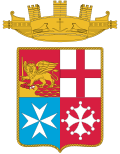 | |
| History | |
|---|---|
| Name | Nicoloso da Recco |
| Namesake | Nicoloso da Recco |
| Builder | Cantieri Riuniti dell'Adriatico |
| Laid down | 14 December 1927 |
| Launched | 5 January 1930 |
| Commissioned | 20 May 1930 |
| Stricken | 15 July 1954 |
| Fate | Scrapped 1954 |
| General characteristics (as built) | |
| Class & type | Navigatori-class destroyer |
| Displacement | |
| Length | 107.3 m (352 ft 0 in) |
| Beam | 10.2 m (33 ft 6 in) |
| Draught | 3.5 m (11 ft 6 in) |
| Installed power |
|
| Propulsion | 2 shafts; 2 geared steam turbines |
| Speed | 32 knots (59.3 km/h; 36.8 mph) |
| Range | 3,800 nmi (7,000 km; 4,400 mi) at 18 knots (33 km/h; 21 mph) |
| Complement | 222–225 (wartime) |
| Armament |
|
Nicoloso da Recco was one of a dozen Navigatori-class destroyers built for the Regia Marina (Royal Italian Navy) in 1930. Named after the Italian Renaissance seaman Nicoloso da Recco, she served during World War II in which she was the sole survivor of her destroyer class. She shot down three Beaufort bombers while escorting a two-freighter convoy on 21 June 1942 off Tunisia. [1] On 2 December 1942 Nicoloso Da Recco took part of the Battle of Skerki Bank, where an Italo-German convoy carrying troops and supplies to Libya was obliterated by Allied naval forces. Nicoloso Da Recco was the only vessel of her class to survive the war, and was eventually scrapped in July 1954.
